Management and Leadership: Theories, Roles, and Situational Analysis
VerifiedAdded on 2020/12/29
|10
|2991
|98
Report
AI Summary
This report delves into the critical aspects of management and leadership, exploring the roles and characteristics of both managers and leaders within organizations. It examines the functions of managers, including self-motivation, integrity, and decision-making, alongside the coordinating and motivational qualities of leaders. The report analyzes situational approaches to leadership, demonstrating how the roles of leaders and managers fluctuate based on specific circumstances. It uses examples to illustrate how managers and leaders handle adverse situations, such as employee issues and customer complaints. Furthermore, the report explores various organizational theories and models, including Lewin's change management model, the McKinsey 7S Model, and different leadership styles such as situational, system, and contingent leadership, assessing the strengths and weaknesses of each approach. The report concludes by discussing how these models are applied and the impact they have on the overall success of an organization.
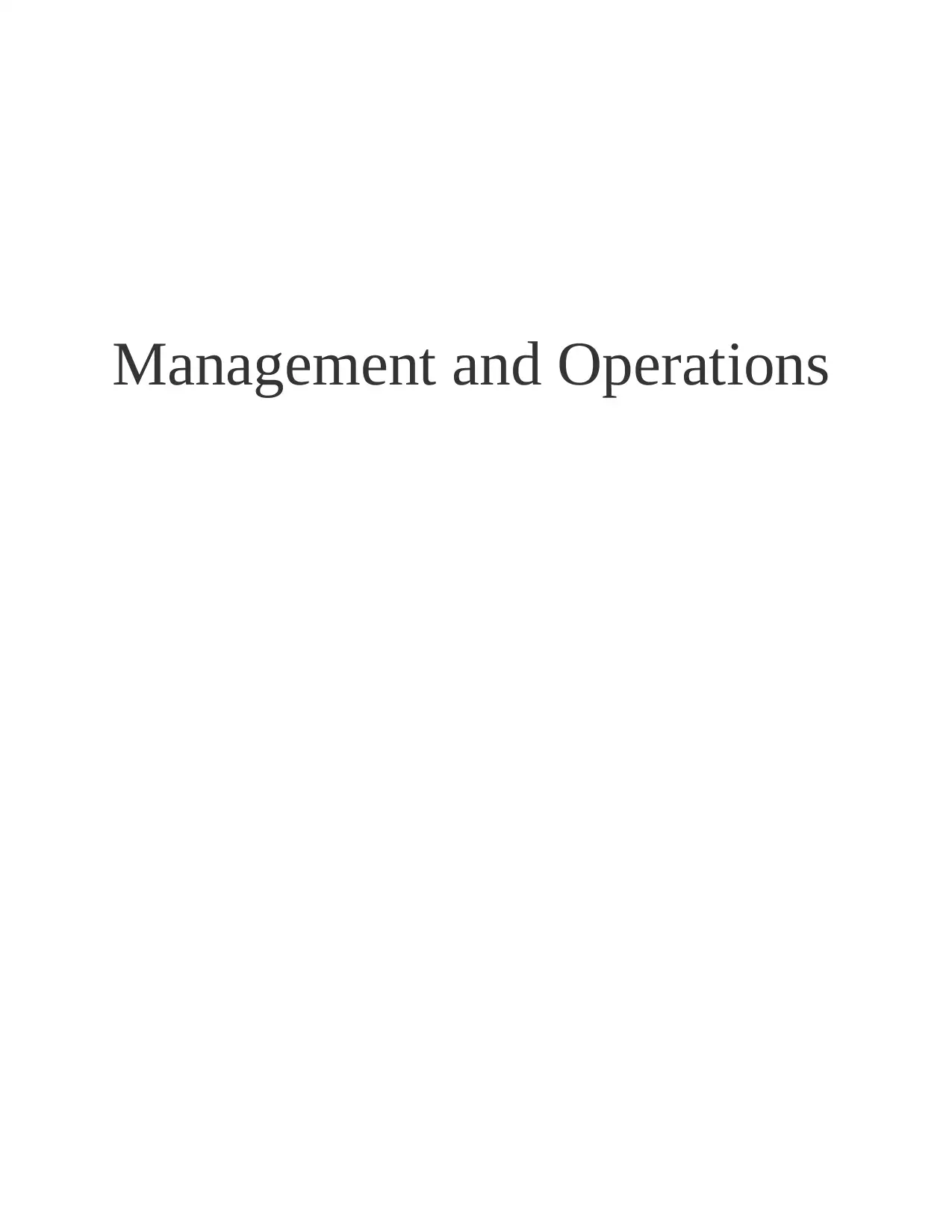
Management and Operations
Paraphrase This Document
Need a fresh take? Get an instant paraphrase of this document with our AI Paraphraser

TABLE OF CONTENTS
INTRODUCTION...........................................................................................................................1
TASK 1............................................................................................................................................1
Q.1. Role and characteristics of a manager and a leader.............................................................1
M1. Analysing the role of a leader and functions of manager in different situations.................2
Q.2. Examine the role of a leader and manager in different situation with examples...............2
Q.3. Different theories and models of approach for an organisation..........................................3
M2 .Assessment of strengths and weakness of different approaches.........................................5
D. Analysing different theories and approaches to leadership ...................................................5
CONCLUSION................................................................................................................................6
REFERENCES................................................................................................................................7
INTRODUCTION...........................................................................................................................1
TASK 1............................................................................................................................................1
Q.1. Role and characteristics of a manager and a leader.............................................................1
M1. Analysing the role of a leader and functions of manager in different situations.................2
Q.2. Examine the role of a leader and manager in different situation with examples...............2
Q.3. Different theories and models of approach for an organisation..........................................3
M2 .Assessment of strengths and weakness of different approaches.........................................5
D. Analysing different theories and approaches to leadership ...................................................5
CONCLUSION................................................................................................................................6
REFERENCES................................................................................................................................7
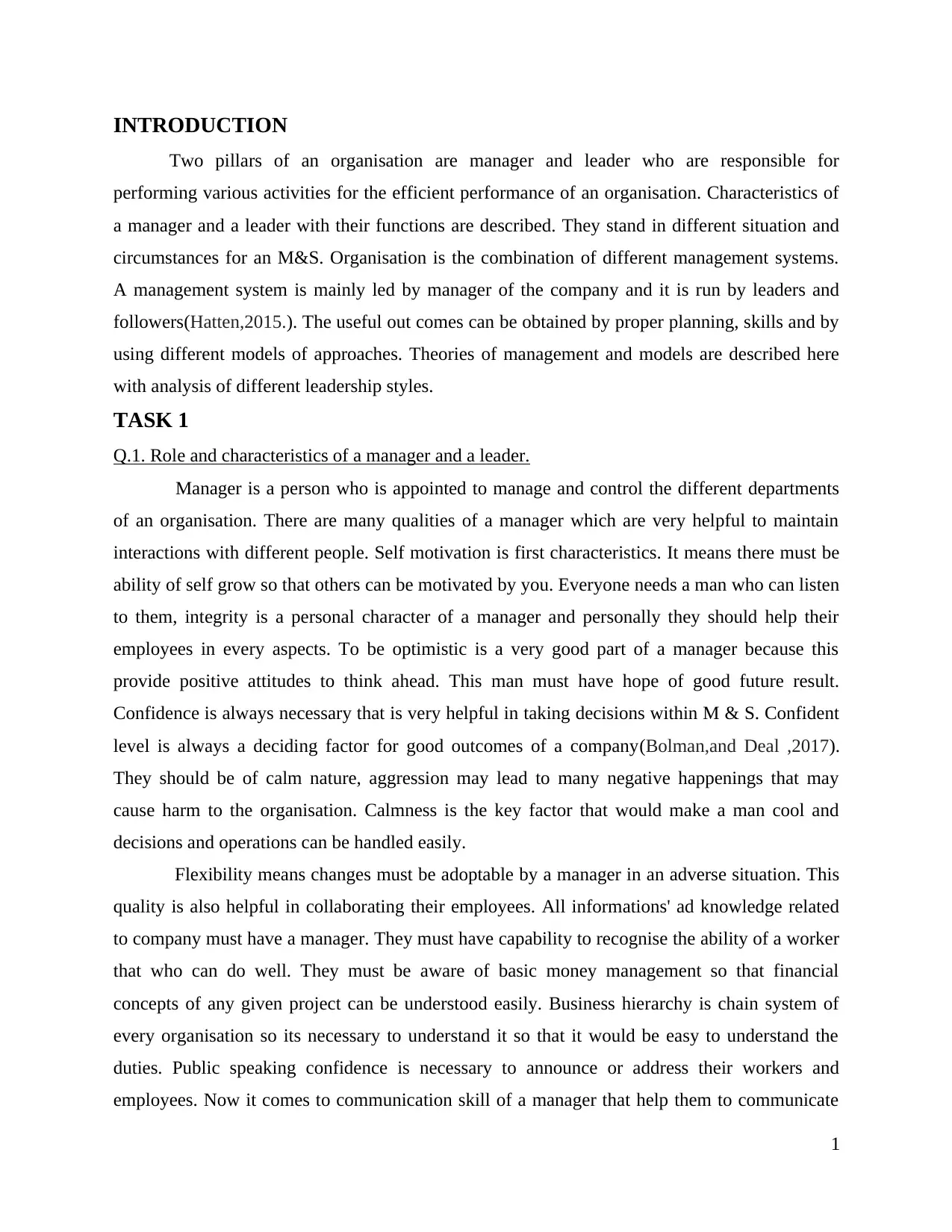
INTRODUCTION
Two pillars of an organisation are manager and leader who are responsible for
performing various activities for the efficient performance of an organisation. Characteristics of
a manager and a leader with their functions are described. They stand in different situation and
circumstances for an M&S. Organisation is the combination of different management systems.
A management system is mainly led by manager of the company and it is run by leaders and
followers(Hatten,2015.). The useful out comes can be obtained by proper planning, skills and by
using different models of approaches. Theories of management and models are described here
with analysis of different leadership styles.
TASK 1
Q.1. Role and characteristics of a manager and a leader.
Manager is a person who is appointed to manage and control the different departments
of an organisation. There are many qualities of a manager which are very helpful to maintain
interactions with different people. Self motivation is first characteristics. It means there must be
ability of self grow so that others can be motivated by you. Everyone needs a man who can listen
to them, integrity is a personal character of a manager and personally they should help their
employees in every aspects. To be optimistic is a very good part of a manager because this
provide positive attitudes to think ahead. This man must have hope of good future result.
Confidence is always necessary that is very helpful in taking decisions within M & S. Confident
level is always a deciding factor for good outcomes of a company(Bolman,and Deal ,2017).
They should be of calm nature, aggression may lead to many negative happenings that may
cause harm to the organisation. Calmness is the key factor that would make a man cool and
decisions and operations can be handled easily.
Flexibility means changes must be adoptable by a manager in an adverse situation. This
quality is also helpful in collaborating their employees. All informations' ad knowledge related
to company must have a manager. They must have capability to recognise the ability of a worker
that who can do well. They must be aware of basic money management so that financial
concepts of any given project can be understood easily. Business hierarchy is chain system of
every organisation so its necessary to understand it so that it would be easy to understand the
duties. Public speaking confidence is necessary to announce or address their workers and
employees. Now it comes to communication skill of a manager that help them to communicate
1
Two pillars of an organisation are manager and leader who are responsible for
performing various activities for the efficient performance of an organisation. Characteristics of
a manager and a leader with their functions are described. They stand in different situation and
circumstances for an M&S. Organisation is the combination of different management systems.
A management system is mainly led by manager of the company and it is run by leaders and
followers(Hatten,2015.). The useful out comes can be obtained by proper planning, skills and by
using different models of approaches. Theories of management and models are described here
with analysis of different leadership styles.
TASK 1
Q.1. Role and characteristics of a manager and a leader.
Manager is a person who is appointed to manage and control the different departments
of an organisation. There are many qualities of a manager which are very helpful to maintain
interactions with different people. Self motivation is first characteristics. It means there must be
ability of self grow so that others can be motivated by you. Everyone needs a man who can listen
to them, integrity is a personal character of a manager and personally they should help their
employees in every aspects. To be optimistic is a very good part of a manager because this
provide positive attitudes to think ahead. This man must have hope of good future result.
Confidence is always necessary that is very helpful in taking decisions within M & S. Confident
level is always a deciding factor for good outcomes of a company(Bolman,and Deal ,2017).
They should be of calm nature, aggression may lead to many negative happenings that may
cause harm to the organisation. Calmness is the key factor that would make a man cool and
decisions and operations can be handled easily.
Flexibility means changes must be adoptable by a manager in an adverse situation. This
quality is also helpful in collaborating their employees. All informations' ad knowledge related
to company must have a manager. They must have capability to recognise the ability of a worker
that who can do well. They must be aware of basic money management so that financial
concepts of any given project can be understood easily. Business hierarchy is chain system of
every organisation so its necessary to understand it so that it would be easy to understand the
duties. Public speaking confidence is necessary to announce or address their workers and
employees. Now it comes to communication skill of a manager that help them to communicate
1
⊘ This is a preview!⊘
Do you want full access?
Subscribe today to unlock all pages.

Trusted by 1+ million students worldwide

effectively with their speaking and written communication. They should know how to organise
their presentation which is helpful in presenting a clear and concise presentation in meetings.
Functions of a manger is always co related with characteristics that they posses. It is important to
understand that they are also a player of organisational team and must have capacity to work
with others. They should always try to make good relationships with other organisation and a
reputed image in market(Aarons ,Ehrhart Farahnak and et.al., 2015). This may be helpful in
maintaining good customer service and to discover customer relationships. Risk must be taken
by a manager for the better growth of M&S.
Leader is an important element of an organisation who directs the functions of a
management. Co-ordinating quality of a leader may help to create interests of workers to achieve
the specific goal. It is true that their decisions are based on others but they can apply new
directions and ways in order to complete the goal. Good personality of a leader may attract the
people. Apart from these there are also many other good qualities of a leader like ability to guide
each other, communicating skills, sociable, self confidence, good understanding and sound
judgement and many more. They must have motive power to motivates their followers. They
must have capability to minimize the risks and to maximize the productivity of an organisation.
M1. Analysing the role of a leader and functions of manager in different situations.
Situational approaches suggest the different style of leader and manager. According to
situation the role of a leader and functions of a manager is fluctuated(Wirtz ,Pistoia,Ullrich and
et.al., 2016). Both have positive attitudes toward goals but the way they work for the same
situation is different. One example is taken here, plans are made by a manger for a specific goal
and the same plan is followed by a leader. But the directions which are chosen by leader may be
different to complete the same goal. A problem that is occurred by a leader is informed to
manager and that will be shorted out by the common discussion of manager and leader. Different
alternative s are analysed by a leader and then the best alternative is selected. The selective
alternative is presented to the followers. Decisions which are taken by a manger also depend
upon the capability of their subordinates. If manager realize that their subordinates are not able
to complete the task then the followers are guided by a leader, after that any decision is taken.
2
their presentation which is helpful in presenting a clear and concise presentation in meetings.
Functions of a manger is always co related with characteristics that they posses. It is important to
understand that they are also a player of organisational team and must have capacity to work
with others. They should always try to make good relationships with other organisation and a
reputed image in market(Aarons ,Ehrhart Farahnak and et.al., 2015). This may be helpful in
maintaining good customer service and to discover customer relationships. Risk must be taken
by a manager for the better growth of M&S.
Leader is an important element of an organisation who directs the functions of a
management. Co-ordinating quality of a leader may help to create interests of workers to achieve
the specific goal. It is true that their decisions are based on others but they can apply new
directions and ways in order to complete the goal. Good personality of a leader may attract the
people. Apart from these there are also many other good qualities of a leader like ability to guide
each other, communicating skills, sociable, self confidence, good understanding and sound
judgement and many more. They must have motive power to motivates their followers. They
must have capability to minimize the risks and to maximize the productivity of an organisation.
M1. Analysing the role of a leader and functions of manager in different situations.
Situational approaches suggest the different style of leader and manager. According to
situation the role of a leader and functions of a manager is fluctuated(Wirtz ,Pistoia,Ullrich and
et.al., 2016). Both have positive attitudes toward goals but the way they work for the same
situation is different. One example is taken here, plans are made by a manger for a specific goal
and the same plan is followed by a leader. But the directions which are chosen by leader may be
different to complete the same goal. A problem that is occurred by a leader is informed to
manager and that will be shorted out by the common discussion of manager and leader. Different
alternative s are analysed by a leader and then the best alternative is selected. The selective
alternative is presented to the followers. Decisions which are taken by a manger also depend
upon the capability of their subordinates. If manager realize that their subordinates are not able
to complete the task then the followers are guided by a leader, after that any decision is taken.
2
Paraphrase This Document
Need a fresh take? Get an instant paraphrase of this document with our AI Paraphraser
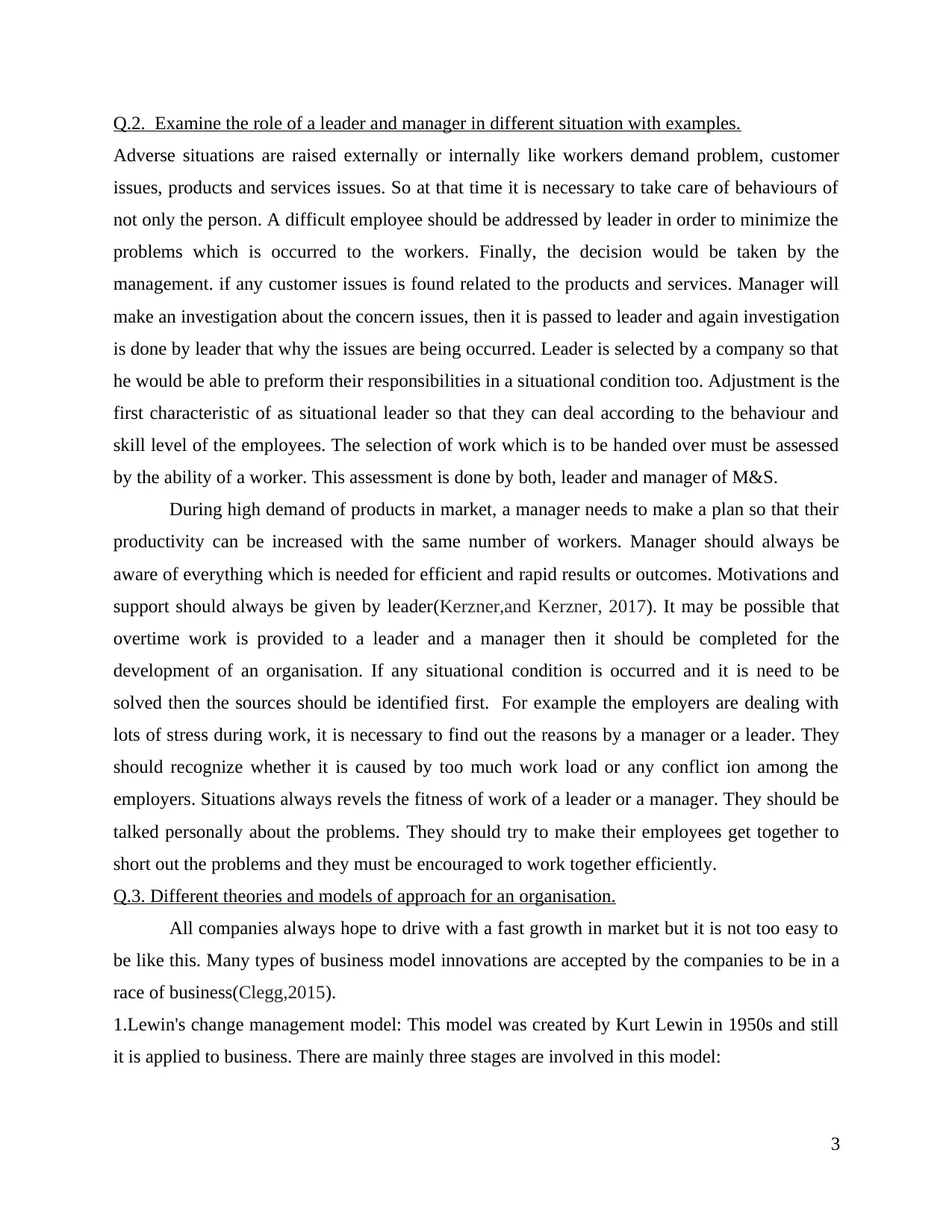
Q.2. Examine the role of a leader and manager in different situation with examples.
Adverse situations are raised externally or internally like workers demand problem, customer
issues, products and services issues. So at that time it is necessary to take care of behaviours of
not only the person. A difficult employee should be addressed by leader in order to minimize the
problems which is occurred to the workers. Finally, the decision would be taken by the
management. if any customer issues is found related to the products and services. Manager will
make an investigation about the concern issues, then it is passed to leader and again investigation
is done by leader that why the issues are being occurred. Leader is selected by a company so that
he would be able to preform their responsibilities in a situational condition too. Adjustment is the
first characteristic of as situational leader so that they can deal according to the behaviour and
skill level of the employees. The selection of work which is to be handed over must be assessed
by the ability of a worker. This assessment is done by both, leader and manager of M&S.
During high demand of products in market, a manager needs to make a plan so that their
productivity can be increased with the same number of workers. Manager should always be
aware of everything which is needed for efficient and rapid results or outcomes. Motivations and
support should always be given by leader(Kerzner,and Kerzner, 2017). It may be possible that
overtime work is provided to a leader and a manager then it should be completed for the
development of an organisation. If any situational condition is occurred and it is need to be
solved then the sources should be identified first. For example the employers are dealing with
lots of stress during work, it is necessary to find out the reasons by a manager or a leader. They
should recognize whether it is caused by too much work load or any conflict ion among the
employers. Situations always revels the fitness of work of a leader or a manager. They should be
talked personally about the problems. They should try to make their employees get together to
short out the problems and they must be encouraged to work together efficiently.
Q.3. Different theories and models of approach for an organisation.
All companies always hope to drive with a fast growth in market but it is not too easy to
be like this. Many types of business model innovations are accepted by the companies to be in a
race of business(Clegg,2015).
1.Lewin's change management model: This model was created by Kurt Lewin in 1950s and still
it is applied to business. There are mainly three stages are involved in this model:
3
Adverse situations are raised externally or internally like workers demand problem, customer
issues, products and services issues. So at that time it is necessary to take care of behaviours of
not only the person. A difficult employee should be addressed by leader in order to minimize the
problems which is occurred to the workers. Finally, the decision would be taken by the
management. if any customer issues is found related to the products and services. Manager will
make an investigation about the concern issues, then it is passed to leader and again investigation
is done by leader that why the issues are being occurred. Leader is selected by a company so that
he would be able to preform their responsibilities in a situational condition too. Adjustment is the
first characteristic of as situational leader so that they can deal according to the behaviour and
skill level of the employees. The selection of work which is to be handed over must be assessed
by the ability of a worker. This assessment is done by both, leader and manager of M&S.
During high demand of products in market, a manager needs to make a plan so that their
productivity can be increased with the same number of workers. Manager should always be
aware of everything which is needed for efficient and rapid results or outcomes. Motivations and
support should always be given by leader(Kerzner,and Kerzner, 2017). It may be possible that
overtime work is provided to a leader and a manager then it should be completed for the
development of an organisation. If any situational condition is occurred and it is need to be
solved then the sources should be identified first. For example the employers are dealing with
lots of stress during work, it is necessary to find out the reasons by a manager or a leader. They
should recognize whether it is caused by too much work load or any conflict ion among the
employers. Situations always revels the fitness of work of a leader or a manager. They should be
talked personally about the problems. They should try to make their employees get together to
short out the problems and they must be encouraged to work together efficiently.
Q.3. Different theories and models of approach for an organisation.
All companies always hope to drive with a fast growth in market but it is not too easy to
be like this. Many types of business model innovations are accepted by the companies to be in a
race of business(Clegg,2015).
1.Lewin's change management model: This model was created by Kurt Lewin in 1950s and still
it is applied to business. There are mainly three stages are involved in this model:
3
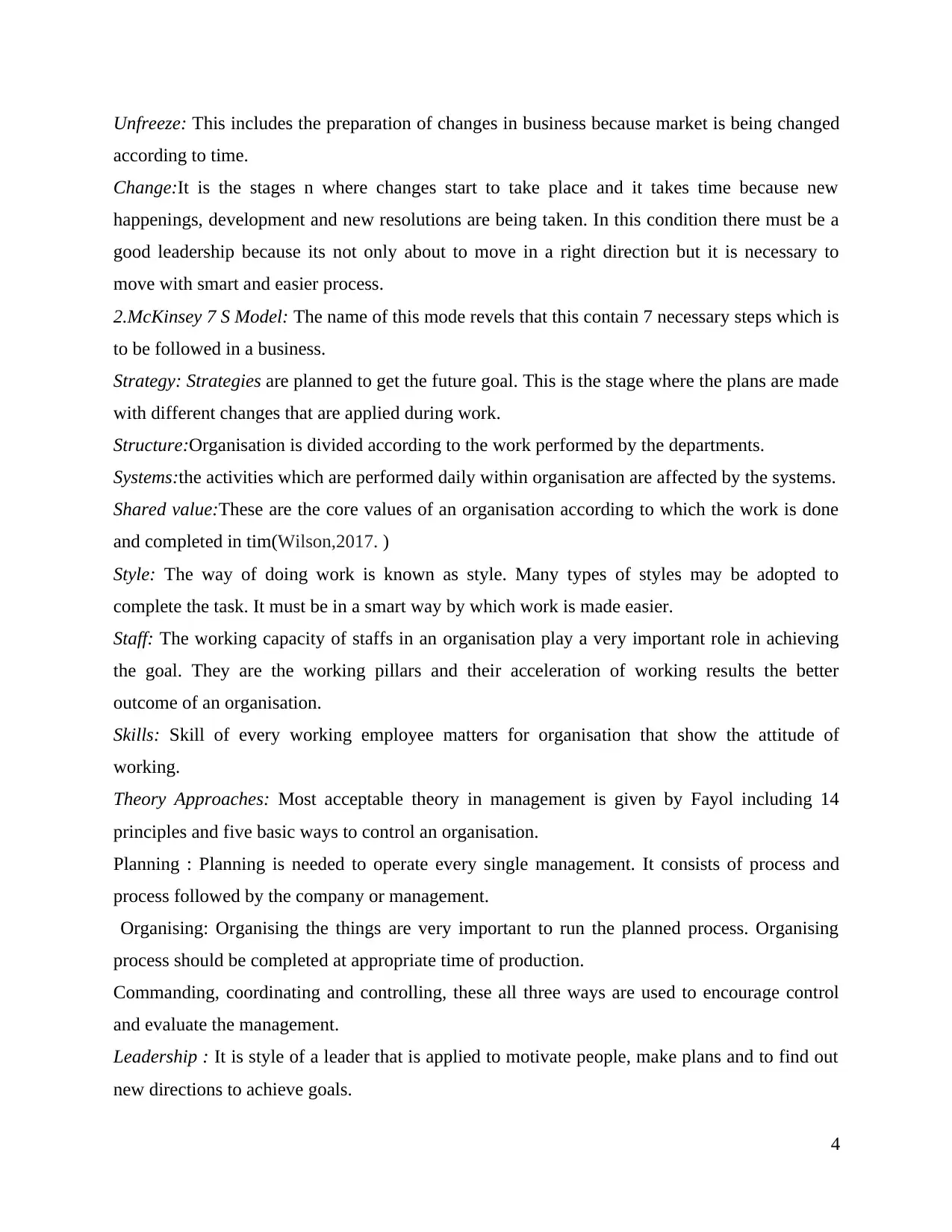
Unfreeze: This includes the preparation of changes in business because market is being changed
according to time.
Change:It is the stages n where changes start to take place and it takes time because new
happenings, development and new resolutions are being taken. In this condition there must be a
good leadership because its not only about to move in a right direction but it is necessary to
move with smart and easier process.
2.McKinsey 7 S Model: The name of this mode revels that this contain 7 necessary steps which is
to be followed in a business.
Strategy: Strategies are planned to get the future goal. This is the stage where the plans are made
with different changes that are applied during work.
Structure:Organisation is divided according to the work performed by the departments.
Systems:the activities which are performed daily within organisation are affected by the systems.
Shared value:These are the core values of an organisation according to which the work is done
and completed in tim(Wilson,2017. )
Style: The way of doing work is known as style. Many types of styles may be adopted to
complete the task. It must be in a smart way by which work is made easier.
Staff: The working capacity of staffs in an organisation play a very important role in achieving
the goal. They are the working pillars and their acceleration of working results the better
outcome of an organisation.
Skills: Skill of every working employee matters for organisation that show the attitude of
working.
Theory Approaches: Most acceptable theory in management is given by Fayol including 14
principles and five basic ways to control an organisation.
Planning : Planning is needed to operate every single management. It consists of process and
process followed by the company or management.
Organising: Organising the things are very important to run the planned process. Organising
process should be completed at appropriate time of production.
Commanding, coordinating and controlling, these all three ways are used to encourage control
and evaluate the management.
Leadership : It is style of a leader that is applied to motivate people, make plans and to find out
new directions to achieve goals.
4
according to time.
Change:It is the stages n where changes start to take place and it takes time because new
happenings, development and new resolutions are being taken. In this condition there must be a
good leadership because its not only about to move in a right direction but it is necessary to
move with smart and easier process.
2.McKinsey 7 S Model: The name of this mode revels that this contain 7 necessary steps which is
to be followed in a business.
Strategy: Strategies are planned to get the future goal. This is the stage where the plans are made
with different changes that are applied during work.
Structure:Organisation is divided according to the work performed by the departments.
Systems:the activities which are performed daily within organisation are affected by the systems.
Shared value:These are the core values of an organisation according to which the work is done
and completed in tim(Wilson,2017. )
Style: The way of doing work is known as style. Many types of styles may be adopted to
complete the task. It must be in a smart way by which work is made easier.
Staff: The working capacity of staffs in an organisation play a very important role in achieving
the goal. They are the working pillars and their acceleration of working results the better
outcome of an organisation.
Skills: Skill of every working employee matters for organisation that show the attitude of
working.
Theory Approaches: Most acceptable theory in management is given by Fayol including 14
principles and five basic ways to control an organisation.
Planning : Planning is needed to operate every single management. It consists of process and
process followed by the company or management.
Organising: Organising the things are very important to run the planned process. Organising
process should be completed at appropriate time of production.
Commanding, coordinating and controlling, these all three ways are used to encourage control
and evaluate the management.
Leadership : It is style of a leader that is applied to motivate people, make plans and to find out
new directions to achieve goals.
4
⊘ This is a preview!⊘
Do you want full access?
Subscribe today to unlock all pages.

Trusted by 1+ million students worldwide
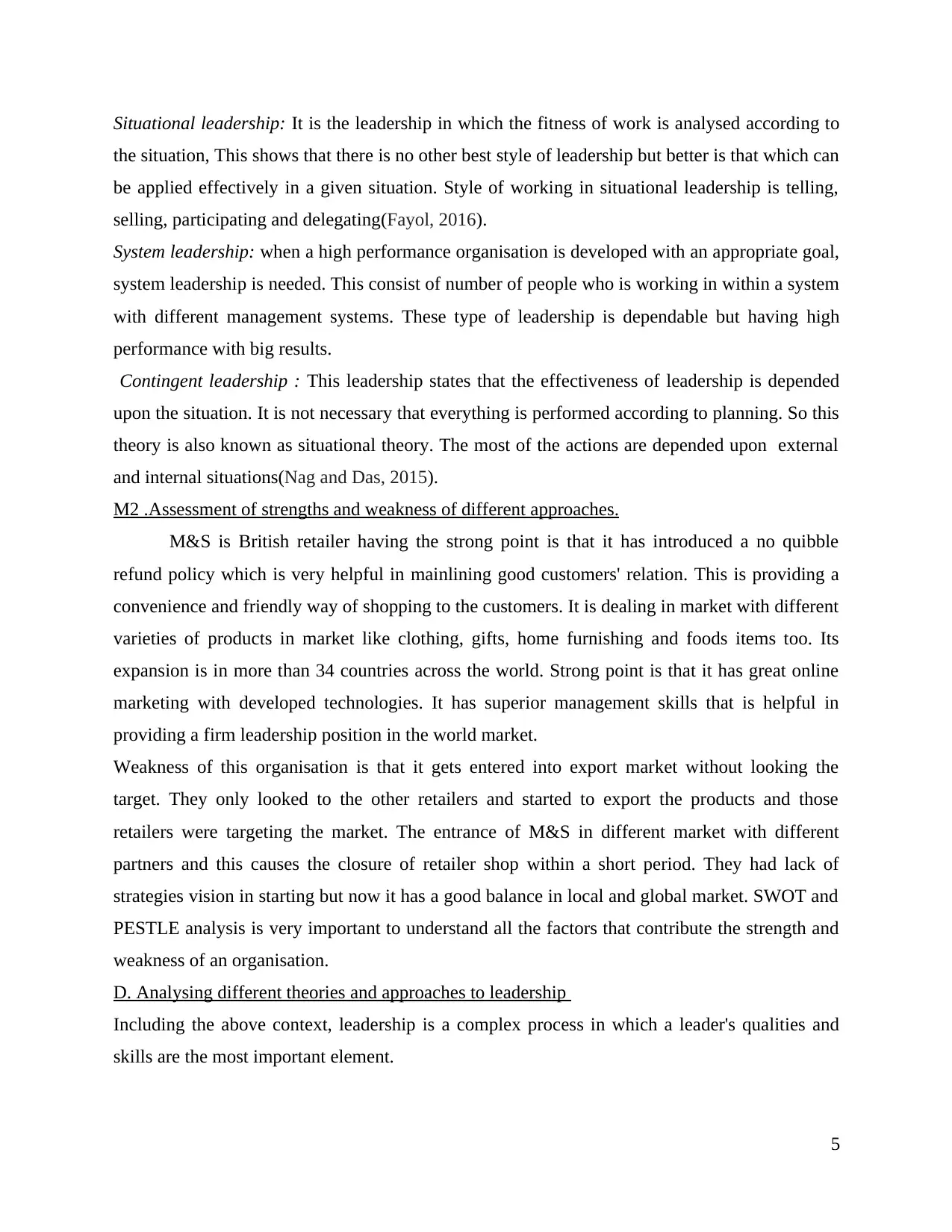
Situational leadership: It is the leadership in which the fitness of work is analysed according to
the situation, This shows that there is no other best style of leadership but better is that which can
be applied effectively in a given situation. Style of working in situational leadership is telling,
selling, participating and delegating(Fayol, 2016).
System leadership: when a high performance organisation is developed with an appropriate goal,
system leadership is needed. This consist of number of people who is working in within a system
with different management systems. These type of leadership is dependable but having high
performance with big results.
Contingent leadership : This leadership states that the effectiveness of leadership is depended
upon the situation. It is not necessary that everything is performed according to planning. So this
theory is also known as situational theory. The most of the actions are depended upon external
and internal situations(Nag and Das, 2015).
M2 .Assessment of strengths and weakness of different approaches.
M&S is British retailer having the strong point is that it has introduced a no quibble
refund policy which is very helpful in mainlining good customers' relation. This is providing a
convenience and friendly way of shopping to the customers. It is dealing in market with different
varieties of products in market like clothing, gifts, home furnishing and foods items too. Its
expansion is in more than 34 countries across the world. Strong point is that it has great online
marketing with developed technologies. It has superior management skills that is helpful in
providing a firm leadership position in the world market.
Weakness of this organisation is that it gets entered into export market without looking the
target. They only looked to the other retailers and started to export the products and those
retailers were targeting the market. The entrance of M&S in different market with different
partners and this causes the closure of retailer shop within a short period. They had lack of
strategies vision in starting but now it has a good balance in local and global market. SWOT and
PESTLE analysis is very important to understand all the factors that contribute the strength and
weakness of an organisation.
D. Analysing different theories and approaches to leadership
Including the above context, leadership is a complex process in which a leader's qualities and
skills are the most important element.
5
the situation, This shows that there is no other best style of leadership but better is that which can
be applied effectively in a given situation. Style of working in situational leadership is telling,
selling, participating and delegating(Fayol, 2016).
System leadership: when a high performance organisation is developed with an appropriate goal,
system leadership is needed. This consist of number of people who is working in within a system
with different management systems. These type of leadership is dependable but having high
performance with big results.
Contingent leadership : This leadership states that the effectiveness of leadership is depended
upon the situation. It is not necessary that everything is performed according to planning. So this
theory is also known as situational theory. The most of the actions are depended upon external
and internal situations(Nag and Das, 2015).
M2 .Assessment of strengths and weakness of different approaches.
M&S is British retailer having the strong point is that it has introduced a no quibble
refund policy which is very helpful in mainlining good customers' relation. This is providing a
convenience and friendly way of shopping to the customers. It is dealing in market with different
varieties of products in market like clothing, gifts, home furnishing and foods items too. Its
expansion is in more than 34 countries across the world. Strong point is that it has great online
marketing with developed technologies. It has superior management skills that is helpful in
providing a firm leadership position in the world market.
Weakness of this organisation is that it gets entered into export market without looking the
target. They only looked to the other retailers and started to export the products and those
retailers were targeting the market. The entrance of M&S in different market with different
partners and this causes the closure of retailer shop within a short period. They had lack of
strategies vision in starting but now it has a good balance in local and global market. SWOT and
PESTLE analysis is very important to understand all the factors that contribute the strength and
weakness of an organisation.
D. Analysing different theories and approaches to leadership
Including the above context, leadership is a complex process in which a leader's qualities and
skills are the most important element.
5
Paraphrase This Document
Need a fresh take? Get an instant paraphrase of this document with our AI Paraphraser
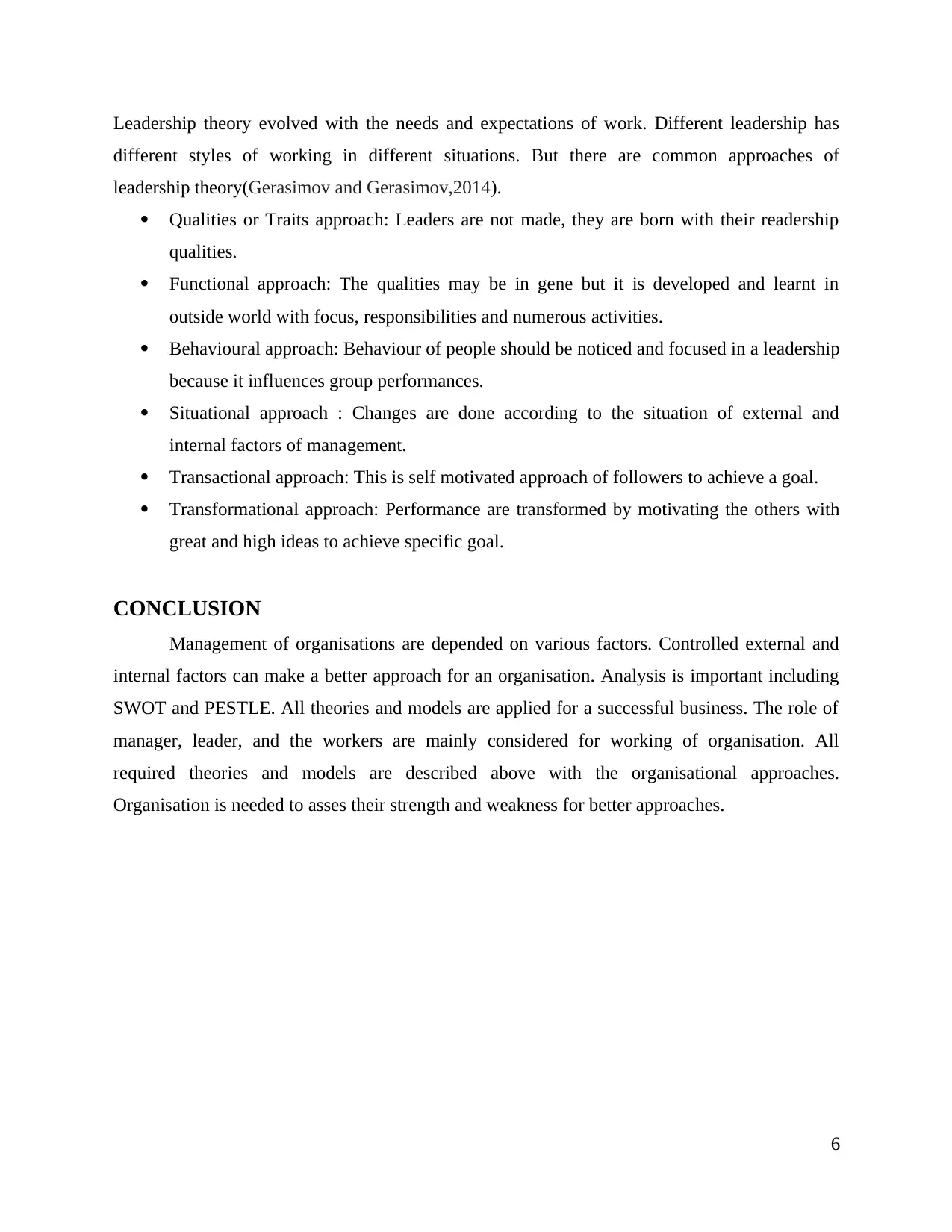
Leadership theory evolved with the needs and expectations of work. Different leadership has
different styles of working in different situations. But there are common approaches of
leadership theory(Gerasimov and Gerasimov,2014).
Qualities or Traits approach: Leaders are not made, they are born with their readership
qualities.
Functional approach: The qualities may be in gene but it is developed and learnt in
outside world with focus, responsibilities and numerous activities.
Behavioural approach: Behaviour of people should be noticed and focused in a leadership
because it influences group performances.
Situational approach : Changes are done according to the situation of external and
internal factors of management.
Transactional approach: This is self motivated approach of followers to achieve a goal.
Transformational approach: Performance are transformed by motivating the others with
great and high ideas to achieve specific goal.
CONCLUSION
Management of organisations are depended on various factors. Controlled external and
internal factors can make a better approach for an organisation. Analysis is important including
SWOT and PESTLE. All theories and models are applied for a successful business. The role of
manager, leader, and the workers are mainly considered for working of organisation. All
required theories and models are described above with the organisational approaches.
Organisation is needed to asses their strength and weakness for better approaches.
6
different styles of working in different situations. But there are common approaches of
leadership theory(Gerasimov and Gerasimov,2014).
Qualities or Traits approach: Leaders are not made, they are born with their readership
qualities.
Functional approach: The qualities may be in gene but it is developed and learnt in
outside world with focus, responsibilities and numerous activities.
Behavioural approach: Behaviour of people should be noticed and focused in a leadership
because it influences group performances.
Situational approach : Changes are done according to the situation of external and
internal factors of management.
Transactional approach: This is self motivated approach of followers to achieve a goal.
Transformational approach: Performance are transformed by motivating the others with
great and high ideas to achieve specific goal.
CONCLUSION
Management of organisations are depended on various factors. Controlled external and
internal factors can make a better approach for an organisation. Analysis is important including
SWOT and PESTLE. All theories and models are applied for a successful business. The role of
manager, leader, and the workers are mainly considered for working of organisation. All
required theories and models are described above with the organisational approaches.
Organisation is needed to asses their strength and weakness for better approaches.
6
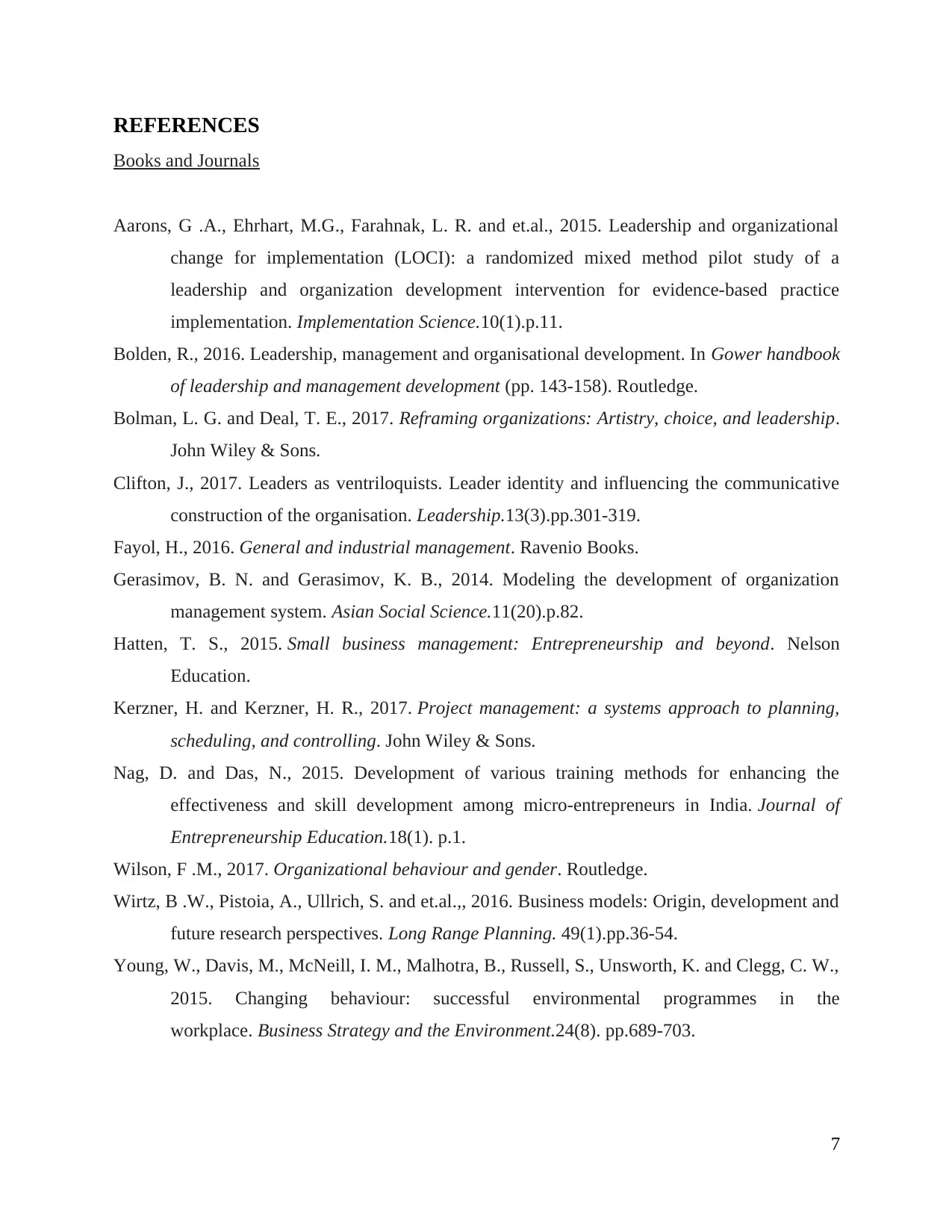
REFERENCES
Books and Journals
Aarons, G .A., Ehrhart, M.G., Farahnak, L. R. and et.al., 2015. Leadership and organizational
change for implementation (LOCI): a randomized mixed method pilot study of a
leadership and organization development intervention for evidence-based practice
implementation. Implementation Science.10(1).p.11.
Bolden, R., 2016. Leadership, management and organisational development. In Gower handbook
of leadership and management development (pp. 143-158). Routledge.
Bolman, L. G. and Deal, T. E., 2017. Reframing organizations: Artistry, choice, and leadership.
John Wiley & Sons.
Clifton, J., 2017. Leaders as ventriloquists. Leader identity and influencing the communicative
construction of the organisation. Leadership.13(3).pp.301-319.
Fayol, H., 2016. General and industrial management. Ravenio Books.
Gerasimov, B. N. and Gerasimov, K. B., 2014. Modeling the development of organization
management system. Asian Social Science.11(20).p.82.
Hatten, T. S., 2015. Small business management: Entrepreneurship and beyond. Nelson
Education.
Kerzner, H. and Kerzner, H. R., 2017. Project management: a systems approach to planning,
scheduling, and controlling. John Wiley & Sons.
Nag, D. and Das, N., 2015. Development of various training methods for enhancing the
effectiveness and skill development among micro-entrepreneurs in India. Journal of
Entrepreneurship Education.18(1). p.1.
Wilson, F .M., 2017. Organizational behaviour and gender. Routledge.
Wirtz, B .W., Pistoia, A., Ullrich, S. and et.al.,, 2016. Business models: Origin, development and
future research perspectives. Long Range Planning. 49(1).pp.36-54.
Young, W., Davis, M., McNeill, I. M., Malhotra, B., Russell, S., Unsworth, K. and Clegg, C. W.,
2015. Changing behaviour: successful environmental programmes in the
workplace. Business Strategy and the Environment.24(8). pp.689-703.
7
Books and Journals
Aarons, G .A., Ehrhart, M.G., Farahnak, L. R. and et.al., 2015. Leadership and organizational
change for implementation (LOCI): a randomized mixed method pilot study of a
leadership and organization development intervention for evidence-based practice
implementation. Implementation Science.10(1).p.11.
Bolden, R., 2016. Leadership, management and organisational development. In Gower handbook
of leadership and management development (pp. 143-158). Routledge.
Bolman, L. G. and Deal, T. E., 2017. Reframing organizations: Artistry, choice, and leadership.
John Wiley & Sons.
Clifton, J., 2017. Leaders as ventriloquists. Leader identity and influencing the communicative
construction of the organisation. Leadership.13(3).pp.301-319.
Fayol, H., 2016. General and industrial management. Ravenio Books.
Gerasimov, B. N. and Gerasimov, K. B., 2014. Modeling the development of organization
management system. Asian Social Science.11(20).p.82.
Hatten, T. S., 2015. Small business management: Entrepreneurship and beyond. Nelson
Education.
Kerzner, H. and Kerzner, H. R., 2017. Project management: a systems approach to planning,
scheduling, and controlling. John Wiley & Sons.
Nag, D. and Das, N., 2015. Development of various training methods for enhancing the
effectiveness and skill development among micro-entrepreneurs in India. Journal of
Entrepreneurship Education.18(1). p.1.
Wilson, F .M., 2017. Organizational behaviour and gender. Routledge.
Wirtz, B .W., Pistoia, A., Ullrich, S. and et.al.,, 2016. Business models: Origin, development and
future research perspectives. Long Range Planning. 49(1).pp.36-54.
Young, W., Davis, M., McNeill, I. M., Malhotra, B., Russell, S., Unsworth, K. and Clegg, C. W.,
2015. Changing behaviour: successful environmental programmes in the
workplace. Business Strategy and the Environment.24(8). pp.689-703.
7
⊘ This is a preview!⊘
Do you want full access?
Subscribe today to unlock all pages.

Trusted by 1+ million students worldwide

8
1 out of 10
Related Documents
Your All-in-One AI-Powered Toolkit for Academic Success.
+13062052269
info@desklib.com
Available 24*7 on WhatsApp / Email
![[object Object]](/_next/static/media/star-bottom.7253800d.svg)
Unlock your academic potential
Copyright © 2020–2025 A2Z Services. All Rights Reserved. Developed and managed by ZUCOL.





